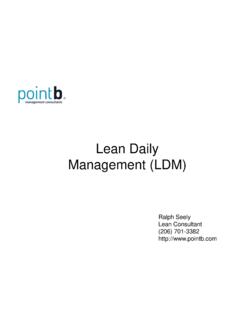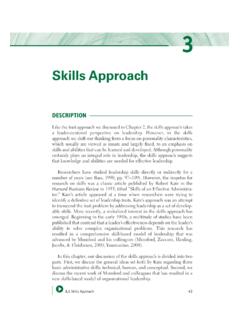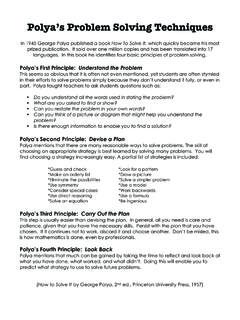Transcription of 6 Step Problem Solving Using the A3 as a Guide - Wa
1 6 Step Problem Solving Using the A3 as a Guide Mike Sullivan Principal Operations & Process Improvement Point B Table of Contents 6 Step Problem Solving Overview and the Benefits of Using the A3 as a Guide Overview of the 6 Step Guide to Problem Solving Using the A3 (with Example) Practical example Using the 6 Step Problem Solving process Questions 2 3 6 Step Problem Solving Process Observe ProblemExplain the ProblemAnalyze Potential CausesFind Root CauseRoot Cause (s)Grasp the Situation/CHECK/ACTPLAN/DOCHECK/ACTFOLLO W UPCOUNTERMEASURE3. Analyze the Causes4. Propose and Implement Countermeasures5. Check/Evaluate1. Identify the Problem2. Set a Target6. Act and/or Standardize6 Step Problem Solving Process What is a Problem Solving Process? 4 5 Ready! Aim! FIRE! Fire, Aim?
2 Ready! Aim, Ready? Fire! 6 Step Problem Solving Process Why Use PDCA? 6 6 Step Problem Solving Process It is every team member s responsibility to improve processes. We want to eliminate waste. Wastes, in all forms, are problems. To eliminate wastes we need to uncover the problems. 7 We use this approach because: It efficiently explains our approach to people whose agreement or approval we need. It documents what we did and why we did it for future Problem -solvers. Those who understand the format can follow the logic of our reasoning, even if they are not experts in this area. It forces us to become better Problem -solvers because we have a structured process to follow. 6 Step Problem Solving Process Where Does A3 Fit In? 8 It s not just a Tool it s a visual manifestation of our thinking to share our wisdom with others.
3 The A3 is only as good as the dialogue that creates it. (? s asked at gemba). The A3 is 5S of information- not everything I did in between. Understanding the importance of the people side of the A3 is more important than the actual tool itself. (Don t just fill in the boxes) Engage, Coach, Involve and Challenge your people at every level. Problem Solving (A3)Report Topic: Date: Name: 1. Identify the Problem Ask: What is the standard Does it reflect the customer s point of view Is understood by those doing the job Are we meeting the standard What is the GAP Gather facts as known from Gemba Who, What, When, Where How important is it to solve this Problem What did you do to contain the Problem Show: A clear statement of the Problem Using sketches, graphs, and charts Tools: Line graph, prioritization Matrix, 4Ws.
4 Tree diagram, pareto diagram 2. Set The Target Ask: What are your intermediate targets (milestones) and when do you expect to achieve them Show: A statement or graph indicating targets 3. Analyze The Causes Ask: Why does this Problem occur Do potential causes map to the know facts What are some reasonable assumptions to make about potential causes (where should we look first) Can we gather more facts to help determine Root Cause Can we explain the cause and effect relationship plausibly Show: How we arrived at the Root Cause Tools: Fishbone diagram, pareto chart, tree diagram 4. Propose and Implement Countermeasures Ask: What countermeasures are most likely to eliminate the Root Cause Which countermeasures are most feasible and effective; likely to cause the least impact; what is the cost, difficulty Can I select the countermeasures that will achieve my targets Show: Countermeasures and why they were selected Tools: Countermeasures Matrix 5.
5 Check/Evaluate Ask: Did the countermeasures work Was the target achieved Can I verify that the Root Cause was eliminated (can I turn it off & on) If the Countermeasure was not effective, why didn t it work Show: The results; describe the reliability of the new process Tools: Line graph, pareto 6. Act and/or Standardize Ask: How will we ensure the process continues to work (stays solved) What have we learned Where else can we apply this learning Show: New or changed procedures, plans to apply learning in other areas Tools: Standard Operating Procedures 9 6 Step Problem Solving Process The Thinking Behind the A3 9 1. Identify the Problem2. Set a Target3. Analyze Causes4. Propose Countermeasures5. Check/Evaluate6. Act/StandardizeShorten the reimbursement process turnaround time to be consistently performed in 6 working days or less by 17 October Member did not know that a receipt was necessary2.
6 Conduct informational sessions to communicate 1 CauseCountermeasure(s)WhoWhen1. Review/revise guidelines and policies for expense 21102 Before Problem SolvingShort-termCountermeasureAfter Problem SolvingStandardization134567891011121314 15161718 Long-termCountermeasure1102 Before Problem SolvingShort-termCountermeasureAfter Problem SolvingStandardization134567891011121314 15161718 Long-termCountermeasureMany complaints regarding the reimbursement process: the reimbursement process takes too of 44 check reimbursements that were investigated took longer than the standard of 6 Report: Reimbursement ProblemDate: _____ Name: _____ 30 September 2008 Rosalie Ramirez6 Step Problem Solving Process A3 Example 10 11 In the Lean Operating System, we achieve operational excellence by.
7 Defining our standards Continuously compare our operations against those standards Engaging in aggressive and rigorous Problem - Solving when there is any deviation from the standard. 6 Step Problem Solving Process 12 Title Step 1: Identify the Problem Step 2: Set the Target Step 3: Analyze the Causes Step 4: Implement Counter-measures Step 5: Check & Evaluate Step 6: Act and/or Standardize 6 Step Problem Solving Process 13 Any deviation from the standard. What should be happening? What is actually happening? Step 1: Identify the Problem Step 1: Identify the Problem Step 2: Set the Target Step 3: Analyze the Causes Step 4: Propose/ Implement countermeasure Step 5: Check & Evaluate Step 6: Act and/or Standardize What Is a Problem ? 14 Title What Is the Standard? A standard, or a standard condition, is a specific, explicit, and known expectation.
8 A standard is either met or not met. What is actually observed (what really happened) is the current condition. This is the first question you must ask when you encounter a Problem . You cannot begin Problem - Solving until you have asked this question. You cannot define a Problem or improve a process without this critical baseline. Step 1: Identify the Problem Step 1: Identify the Problem Step 2: Set the Target Step 3: Analyze the Causes Step 4: Propose/ Implement countermeasure Step 5: Check & Evaluate Step 6: Act and/or Standardize 13 15 Title Grasp the actual situation based on facts and go and see . Big Vague Problem Observe Current Situation Study Existing Data Awareness of the Problem Preliminary Findings Step 1: Identify the Problem Step 1: Identify the Problem Step 2: Set the Target Step 3: Analyze the Causes Step 4: Propose/ Implement countermeasure Step 5: Check & Evaluate Step 6: Act and/or Standardize 14 16 Title Trisha's Finish Tim e vs Top 10 is haTop 10 MinutesWhat is the Gap?
9 Current Situation: 13th Place out of 30 Master Females at Cascade Edge Sprint Triathlon Ideal Situation: Top 10 of the Master Females in a Sprint Triathlon Race Step 1: Identify the Problem Step 1: Identify the Problem Step 2: Set the Target Step 3: Analyze the Causes Step 4: Propose/ Implement countermeasure Step 5: Check & Evaluate Step 6: Act and/or Standardize 15 17 Title Dig a little deeper! Stratification by Leg of Race Minutes 0 5 10 15 20 25 30 35 Percent of Gap Trisha Top 10 Gap 5% 26% 8% 31% 19% Swim T1 Bike T2 Run Step 1: Identify the Problem Step 1: Identify the Problem Step 2: Set the Target Step 3: Analyze the Causes Step 4: Propose/ Implement countermeasure Step 5: Check & Evaluate Step 6: Act and/or Standardize 16 18 Title Don Hat & Belt while Exiting T2 Grab Hat & Race Belt w/Number Put On Running Shoes Remove Cycling Shoes Remove Helmet Rack Bike Dismount & run to transition spot 0:46 Trisha's Leg 4 Times 0:45 0:02 0:45 0:45 0:02 0:03 Largest area for improvement Still deeper!
10 % Improvement Needed05101520253035T2T1 RunBikeSw imLeg of Race% Gap31 26 19 8 5 Step 1: Identify the Problem Step 1: Identify the Problem Step 2: Set the Target Step 3: Analyze the Causes Step 4: Propose/ Implement countermeasure Step 5: Check & Evaluate Step 6: Act and/or Standardize 17 19 Title Reduce Cycling to Running Shoe changeover time: From: 90 Seconds (0:45+0:45) To: 32 Seconds Net Improvement: 58 seconds (By the Seafair Triathlon on 7/15/07). Triathlon Target Step 2: Set the Target Step 1: Identify the Problem Step 2: Set the Target Step 3: Analyze the Causes Step 4: Propose/ Implement countermeasure Step 5: Check & Evaluate Step 6: Act and/or Standardize 18 20 Title Excessive Time to Change over from Cycling to Running Shoes Running Shoe Design Cycling Shoe Design Shoe lace Design Machines / Equipment Man power Methods Environment Motivation / Effort Long Finger Nails Physical Condition in T2 Mental Condition in T2 Lack of time display Adjustments, Rework from T 1 Socks or No Socks Rain Cold Soggy & Wet Muddy Inadequate Practice Staging of Running Shoes Sit or Stand Triathlon Cause and Effect Diagram Root Cause Step 3: Analyze the Causes Step 1: Identify the Problem Step 2: Set the Target Step 3.










